Summary of Traffic Stops Statistics
Wilmington Police Department
The following report compiles and presents statistical summaries of traffic stops statistics drawn from the NC State Bureau of Investigation database to which each police agency reports their statistics each month. Data in this report cover the period of 2002 through 2020. The data exclude checkpoint stops because such stops are not recorded systematically. The data also include only the driver of the vehicle, excluding any passengers. Passenger information is generally recorded only in the event of an adverse outcome (e.g., search, arrest).
This report provides the following summary statistics:
First is a table providing summary statistics on numbers of stops, searches, contraband hits, and arrests, as well as relevant rates of these outcomes. This is followed by a series of graphics displaying department and officer level data.
| Summary of outcomes | State-wide | WPD |
|---|---|---|
| Stops | 24,980,776 | 258,622 |
| Traffic Safety Stops | 13,365,910 | 129,627 |
| Searches | 763,343 | 11,730 |
| Hits | 280,152 | 3,862 |
| Arrests | 500,040 | 9,176 |
| Arrest From Hit From Search | 105,784 | 1,900 |
| Consent Searches | 346,475 | 4,920 |
| Arrest From Hit From Consent Search | 20,759 | 305 |
| Probable Cause Searches | 264,963 | 4,310 |
| Arrest From Hit From Probable Cause Search | 54,326 | 1,123 |
| Percent Traffic Safety Stops | 53.50% | 50.12% |
| Search Rate Per Stop | 3.06% | 4.54% |
| Hit Rate Per Search | 33.48% | 30.30% |
| Arrest Rate Per Hit | 38.85% | 50.36% |
| Hit-and-Arrest Rate Per Search | 13.86% | 16.20% |
| Hit-and-Arrest Rate Per Probable Cause Search | 20.50% | 26.06% |
| Hit-and-Arrest Rate Per Consent Search | 5.99% | 6.20% |
| Arrest Rate Per Stop | 2.00% | 3.55% |
| Hit-and-Arrest Rate Per Stop | 0.42% | 0.73% |
Numbers at top of the table show raw values; numbers below are the percentages based on the numbers above.

Figure 1 shows the total number of stops per year from 2002-2020. Numbers range from approximately 3,000 (in 2005) to almost 21,000 (in 2013). There is a drop associated with the global pandemic in 2020.
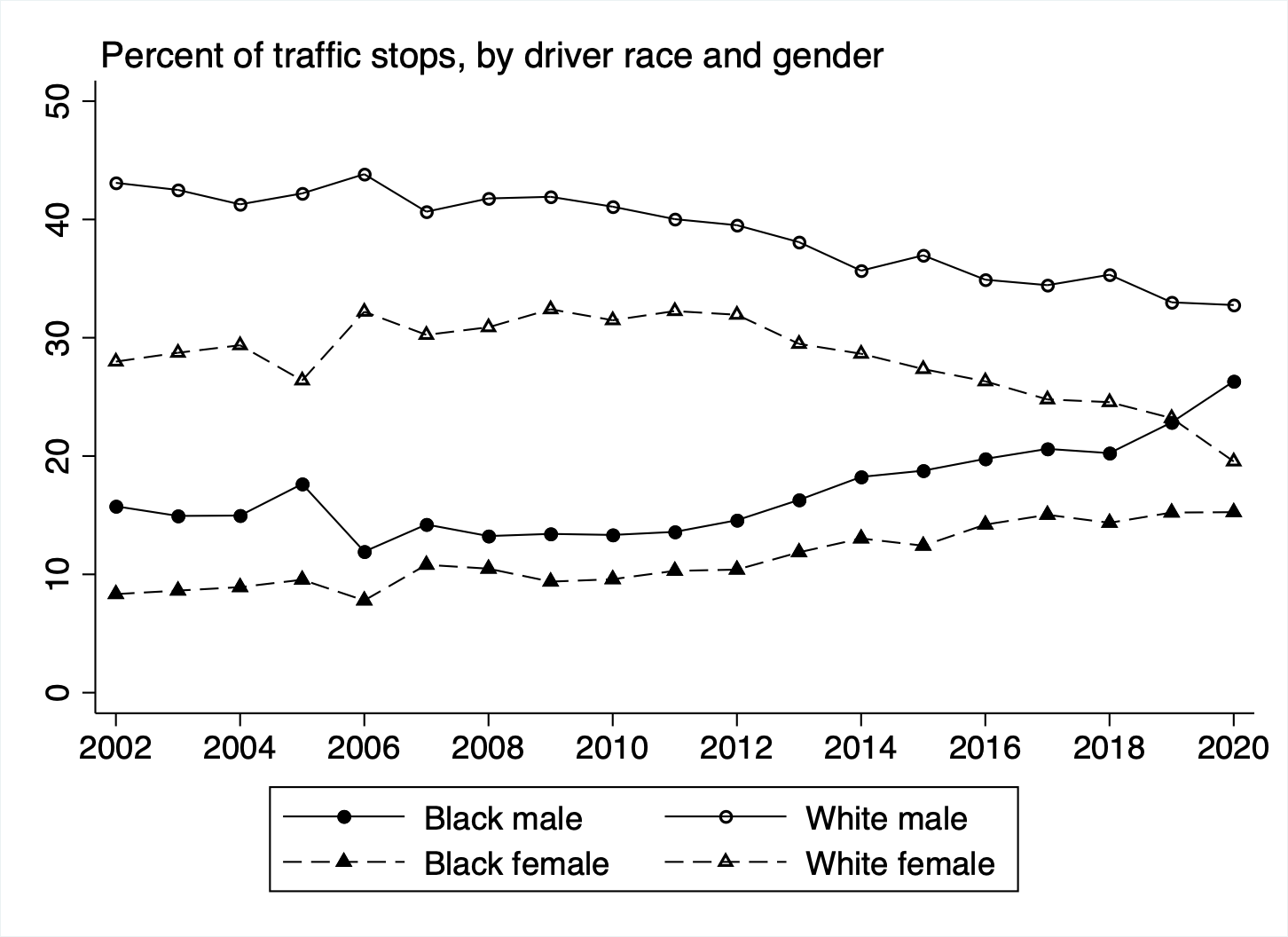
Figure 2 shows the total number of traffic stops by race and gender from 2002-2020. For example, in 2002, roughly 43% of total traffic stops were of white males, roughly 28% of stops were of white females, roughly 16% were of black males, and roughly 9% were of black females. White drivers’ share of those stopped decreased over the timeframe, while both black males and females slightly increased as a proportion of total stops.
Figure 3. Percent of stops for “safety” purposes (speeding, stop sign, DUI, unsafe movement)

Figure 3 shows the percentage of traffic stops that are considered safety-related for each respective race and gender grouping, from 2002-2020. Safety-related spots are composed of stops due to speeding, stop sign violations, DWI, and unsafe movement. Stops for violations other than this are classified as non-safety related. These are composed of non-moving violations such as equipment violations and expired tags. For this reason, non-safety-related stops can be considered to be used as informal criminal investigations. Each race and gender grouping follows a similar trend from 2002-2020. White females and white males have a similar percentage of safety-related stops throughout the time period. Black drivers consistently had a lower percentage of their stops classified as safety-related as compared to white drivers.
Figure 4. Percent of stops resulting in a search, by race-gender category
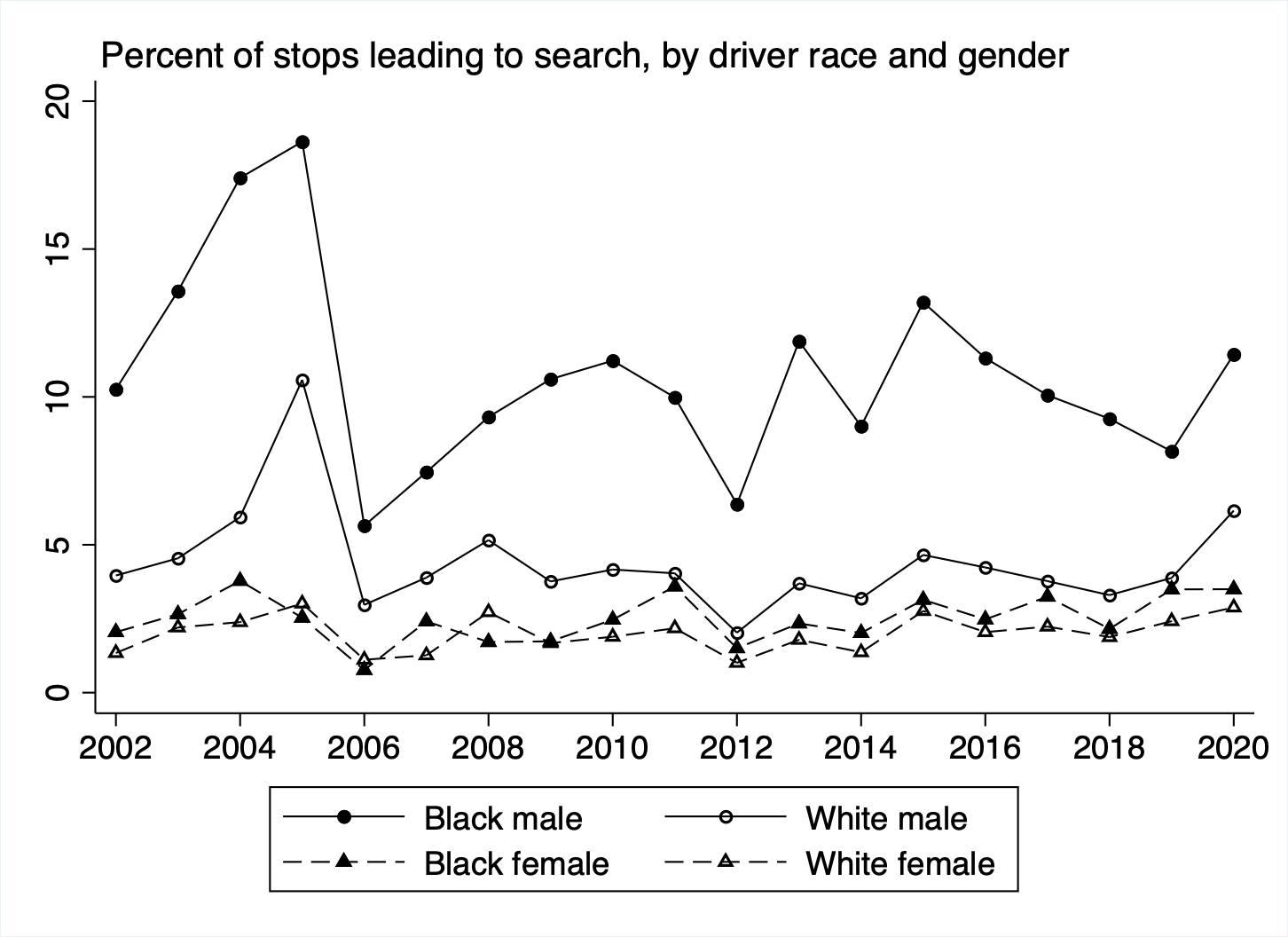
Figure 4 shows the percent of traffic stops that result in a search for each respective race and gender grouping, from 2002-2020. The Figure indicates that most traffic stops do not result in a search. For all categories except black males, drivers were searched at less than a 11% rate across the time period. Black males were typically searched at higher rates, ranging from 5 to 18% across the time period. White males were searched at lower rates, typically at 5% or below with an exception in 2005, when they were searched in 10% of stops. White and black female drivers experienced similar levels of search rates over the time period, with both groups being searched at a lower rate than white and black males.
Figure 5. Percent of stops resulting in arrest, by race-gender category

Figure 5 shows the percent of traffic stops that result in an arrest for each respective race and gender grouping, from 2002-2020. Across the board, arrest rates are consistently very low, at under 10% for all categories across the time period, with the exception of black males in 2020. Black males are arrested at the highest rate, ranging from 3% to 11% across the time period. White males are typically arrested at the second highest rate, although there are a few exceptions, with black females being arrested at marginally higher rates in 2007 and 2016. Typically, female drivers were still arrested at the lowest rates. In 2006, arrest data is missing and therefore is not displayed in the Figure.
Figure 6. Percent of stops resulting in contraband and arrest, by race-gender category
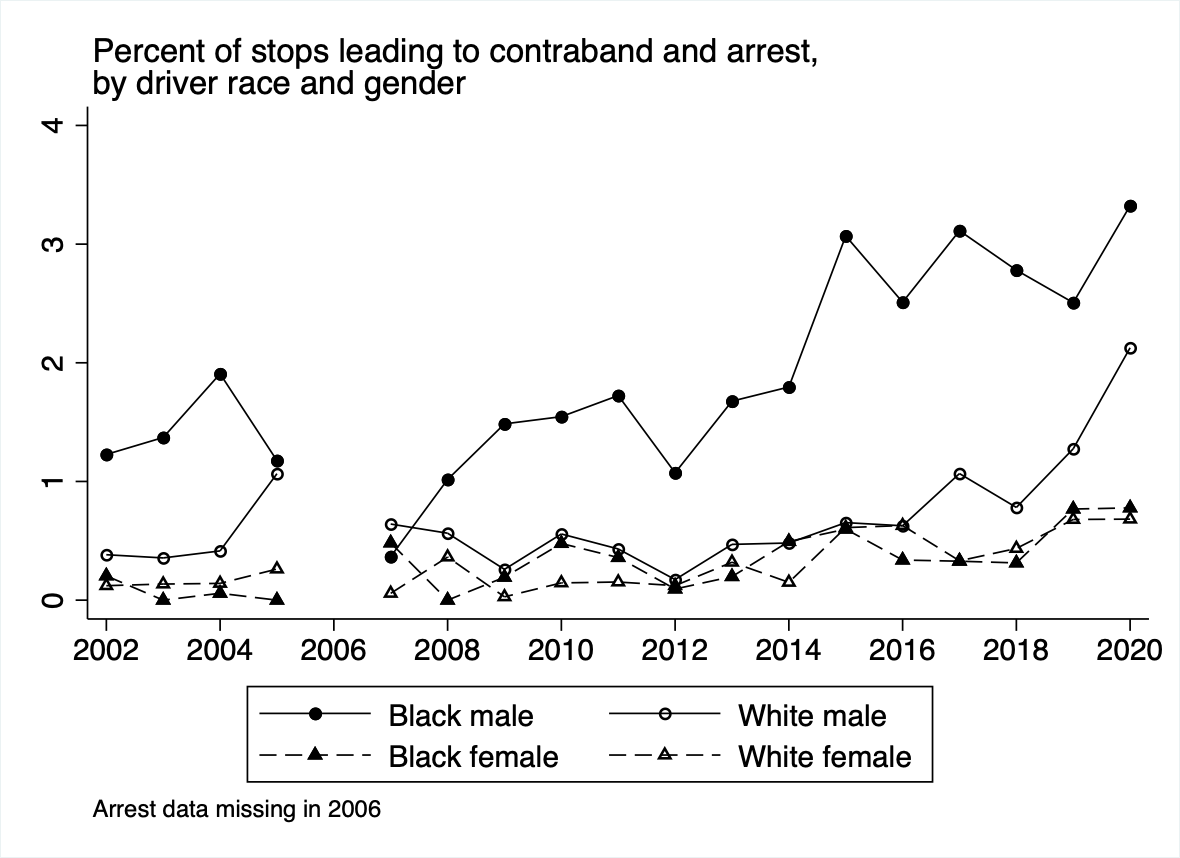
Figure 6 shows the percent of stops that resulted in the discovery of contraband and an arrest for each respective race and gender grouping, from 2002-2020. The rates are very low for each category. White males, white females, and black females all have rates of less than 1.5% across the time period with the exception of white males in 2020. The rates for black males are typically higher, with contraband discovery and arrest consistently occurring in 1% to 3% of stops. Overall, for all race and gender categories, traffic stops are overwhelmingly unlikely to result in contraband and arrest. In 2006, arrest data is missing and therefore is not displayed in the Figure.
Figure 7. Black-White Ratio of search rates and arrest rates, for males
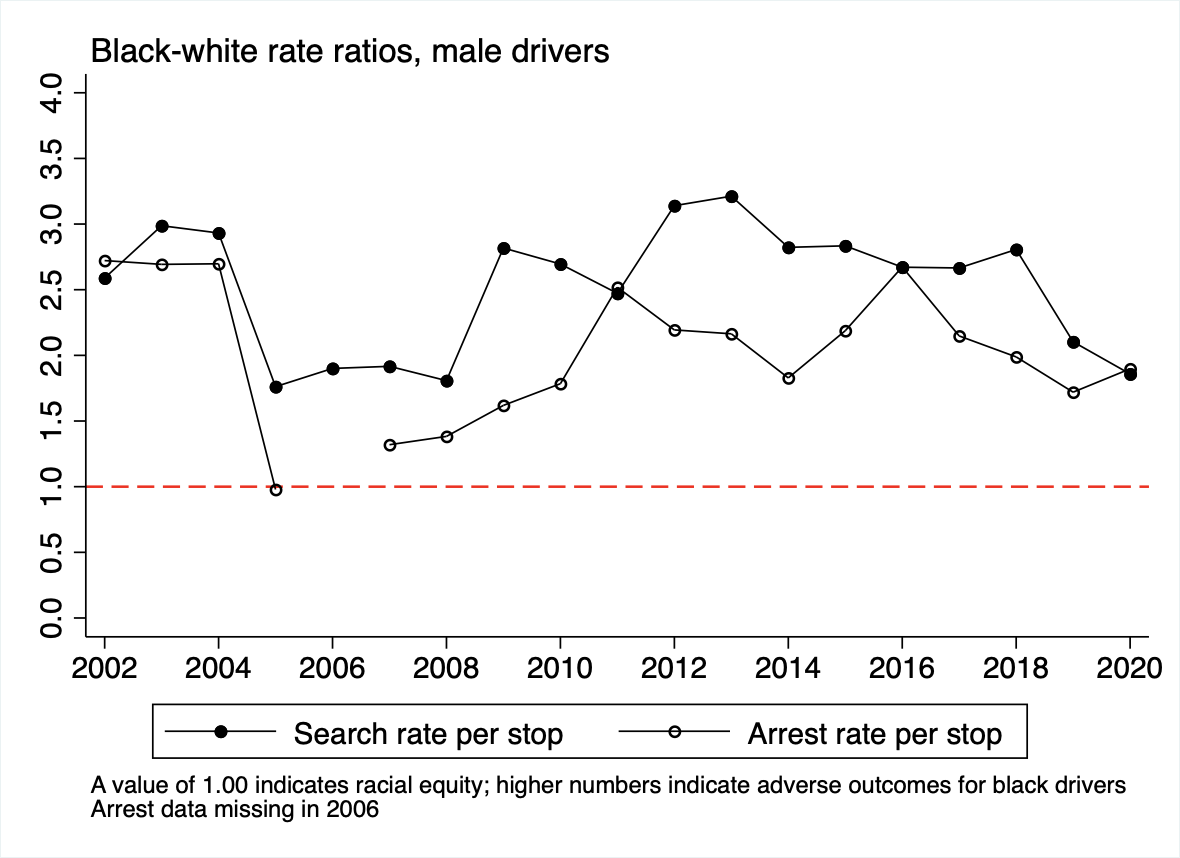
Figure 7 compares the search rate and arrest rate of black males and white males from 2002-2020. The search rate ratio is the search rate of black males divided by the search rate of white males, while the arrest rate ratio is the arrest rate of black males divided by the arrest rate of white males. A search rate ratio of 1.0 would indicate that black and white males are both searched in an equal percentage of their respective traffic stops. This similarly applies for the arrest rate ratios. Across the time period, the search rate ratio is consistently above 1.5, peaking at greater than 3.0 in 2012 and 2013. This means that black males are searched much more frequently than white males. The arrest rate ratio is on average lower than the search rate ratio of the same year, with some exceptions across the time period in which the arrest rate ratio was marginally higher. This means that black males are arrested at a greater rate than white males, but typically not to the degree that they are disproportionately searched. In 2006, arrest data is missing and therefore there is no arrest rate ratio for these years.
Figure 8. Black-White Ratio of search rates and arrest rates, for females
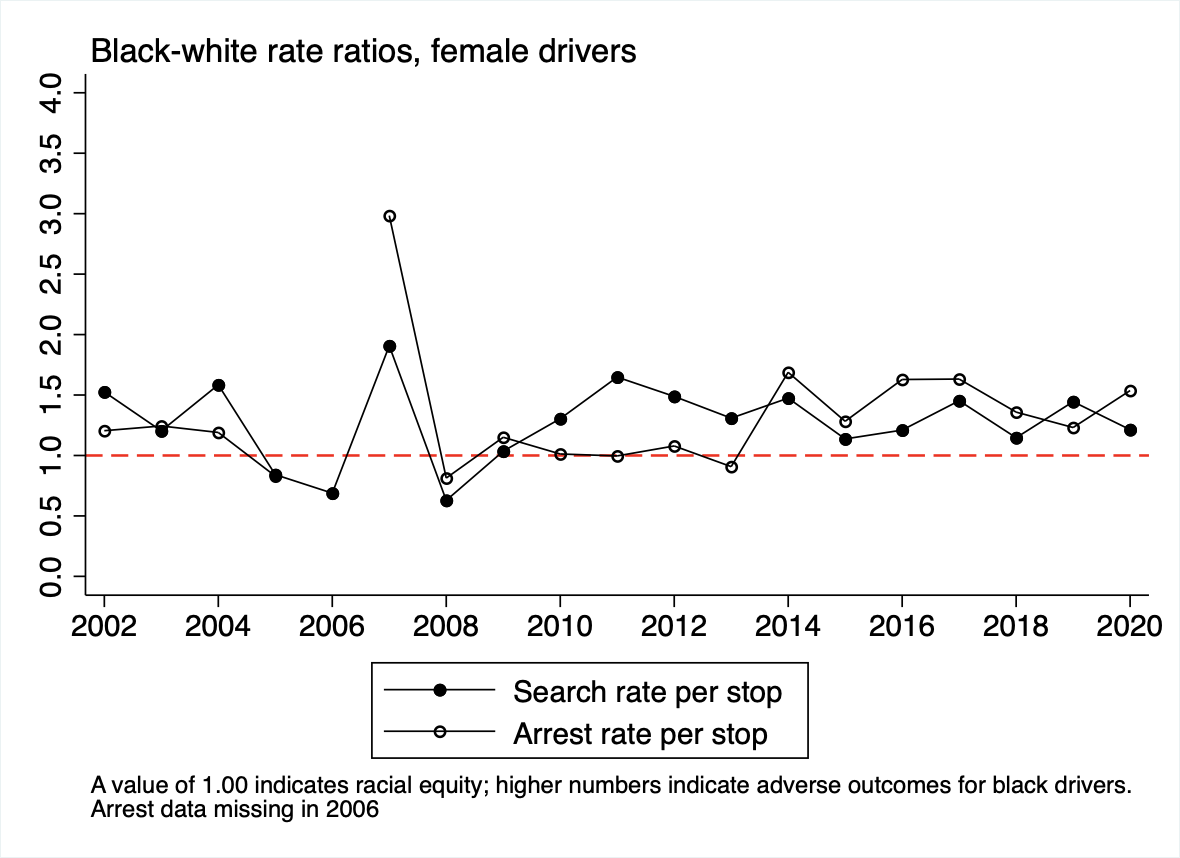
Figure 8 compares the search rate and arrest rate of black females and white females from 2002-2020. The search rate ratio is the search rate of black females divided by the search rate of white females, while the arrest rate ratio is the arrest rate of black females divided by the arrest rate of white females. A search rate ratio of 1.0 would indicate that black and white females are both searched in an equal percentage of their respective traffic stops. Across the time period, the search rate ratio ranges from 0.6 to 2.0. The arrest rate ratio is typically close to the search rate ratio for each given year, with various instances of it being higher or lower. In 2006, arrest data is missing and therefore there is no arrest rate ratio for these years.
Figure 9. Summary of stops by hour over the week: Stops, percent safety-related, percent ending in citation, search, and arrest

Figure 9 displays the number of traffic stops, the percent of safety related stops, the percentage of drivers receiving a citation, the percentage of drivers searched, and the percentage of drivers arrested across the hours of the week. The Figure indicates that there is not much variation between the days of the week in regard to these measures, and instead shows that the variation is seen within the hours of the day. There are a few noticeable trends throughout the week, however. Stops occur most frequently on Thursday, Friday and Saturday nights relative to other days at the same time. Citation rates are lowest on Saturday and Sunday relative to the rest of the week. Search rates are lowest on Saturday and Sunday, and arrest rates are highest on the early morning hours of Thursday and Friday.
Figure 10. Summary of stops by hour over the day: Stops, percent safety-related, percent ending in citation, search, and arrest

Figure 10 displays the number of traffic stops, the percent of safety related stops, and the percent of drivers searched, given a citation, and arrested by hour of day. There are a number of clear trends indicated in the Figure. The frequency of a traffic stop is lowest in the early hours of the morning, from around 3AM to 6AM. The number of traffic stops increases until 10AM, at which the frequency is similar until around 6PM. From 6PM to 10PM stops increase, and the frequency of stops then begins to drop.
The percentages of drivers searched and arrested both have a similar trend across the time of day. Drivers are both searched and arrested at the highest rate in the few hours after midnight, and then these rates of search and arrest decrease dramatically until 6AM. After 6AM, the rate of both search and arrest is at extremely low percentages, and both slowly increase throughout the daytime and into the late night time hours.
The percentage of drivers receiving a citation follows an opposite trend of search and arrest rates. The rate of citations given is at its lowest from 8PM to 4AM (with a sharp increase at midnight), and then in the following hours steadily increases. The rate is significantly higher during daytime hours as compared to nighttime hours.
The percent of safety-related stops varies throughout the day, reaching its highest point at 6AM and then slowly decreasing for the rest of the day until a minimum is reached at 9PM.
Figure 11. Hourly breakdown of percent of stops by race-gender category
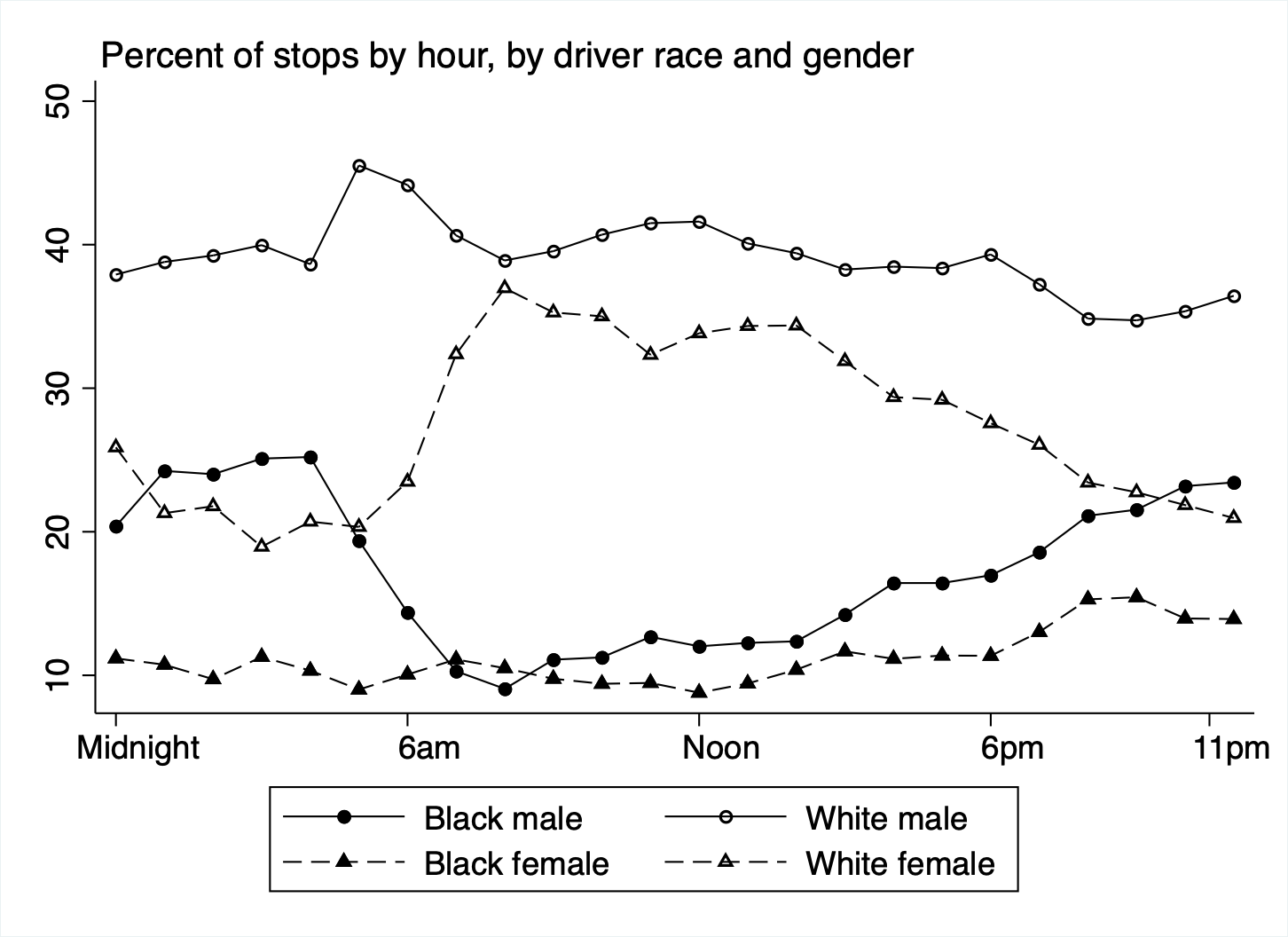
Figure 11 displays the share of overall stops represented by the respective race and gender categories by hour of day. The Figure indicates that black males are more likely to be stopped during the nighttime hours directly before and after midnight than they are to be stopped during the daytime. At 4AM, black males reach a high of 25% of those that are pulled over, and by 8AM their share of stops decreases to below 10%, and stays at a lower proportion of stops throughout the daytime hours. White males, in contrast, make up a relatively consistent share of the overall traffic stops throughout the day, at around 40%. There are no significant variations during the daytime or nighttime. Black females make up a relatively consistent share of traffic stops throughout the day, at roughly 10 to 15%. White females have the opposite trend of black males, seeing a major uptick in their proportion of stops during the daytime hours.
Figure 12. Hourly breakdown of percent of stops related to traffic safety, by race-gender category
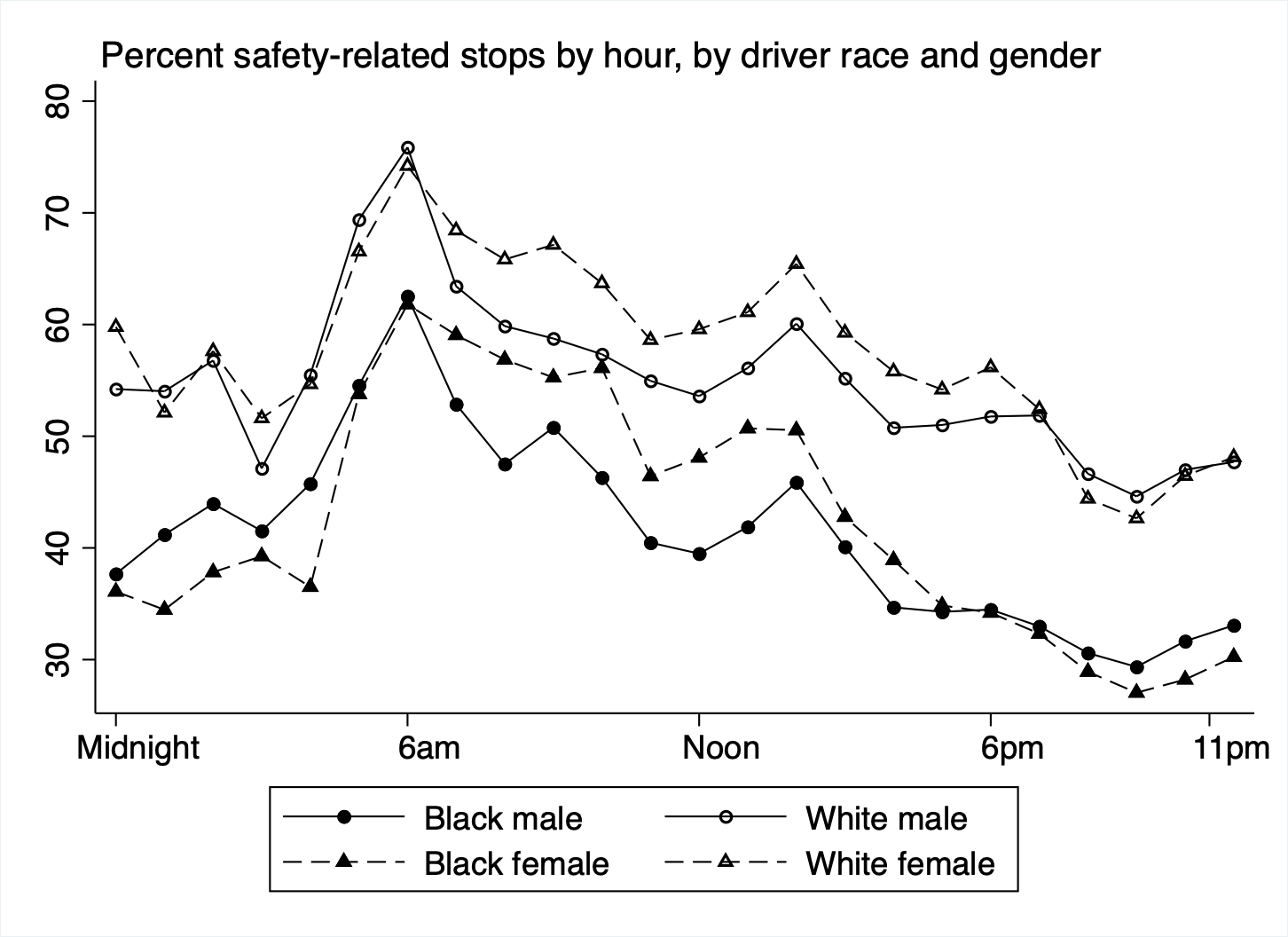
Figure 12 displays the percentage of stops that are for safety-related purposes for each race and gender category, by hour of the day. Safety-related purposes refer to traffic stops that are meant to prevent moving violations, and effectively keep the road safe. Stops that are not safety-related are often used for investigatory purposes, in which case the officer is generally seeking to conduct an informal criminal investigation of the driver. As evidenced in the Figure, black drivers are less likely to be stopped for safety-related purposes than white drivers throughout the course of the day. In turn, this means that black drivers are more likely to be subjected to investigative stops that are not for moving violations. These stops are most common during the nighttime hours, when the percentage of safety-related stops is lowest. At any given hour of the day, black drivers are more likely to be stopped for a non safety-related purpose than white drivers, but this disparity is greater during nighttime hours.
Figure 13. Hourly breakdown of percent of stops resulting in search, by race-gender category

Figure 13 displays the percentage of traffic stops which result in a search for each race and gender category, by hour of the day. Black males are searched at the highest rate regardless of time of day, but the time of day does significantly influence the rate at which they are searched. From approximately 3PM to 4AM, black males are most likely to be searched during a traffic stop, and this search rate decreases during the early morning to early afternoon hours. White males and all female drivers also see increased searches in the hours before and after midnight. During the daytime, these race and gender categories have similar rates of searches as well, at significantly lower rates of search than black males. The Figure also indicates that a majority of stops do not result in a search regardless of race and gender category or time of day.
Figure 14. Hourly breakdown of percent of stops resulting in arrest, by race-gender category
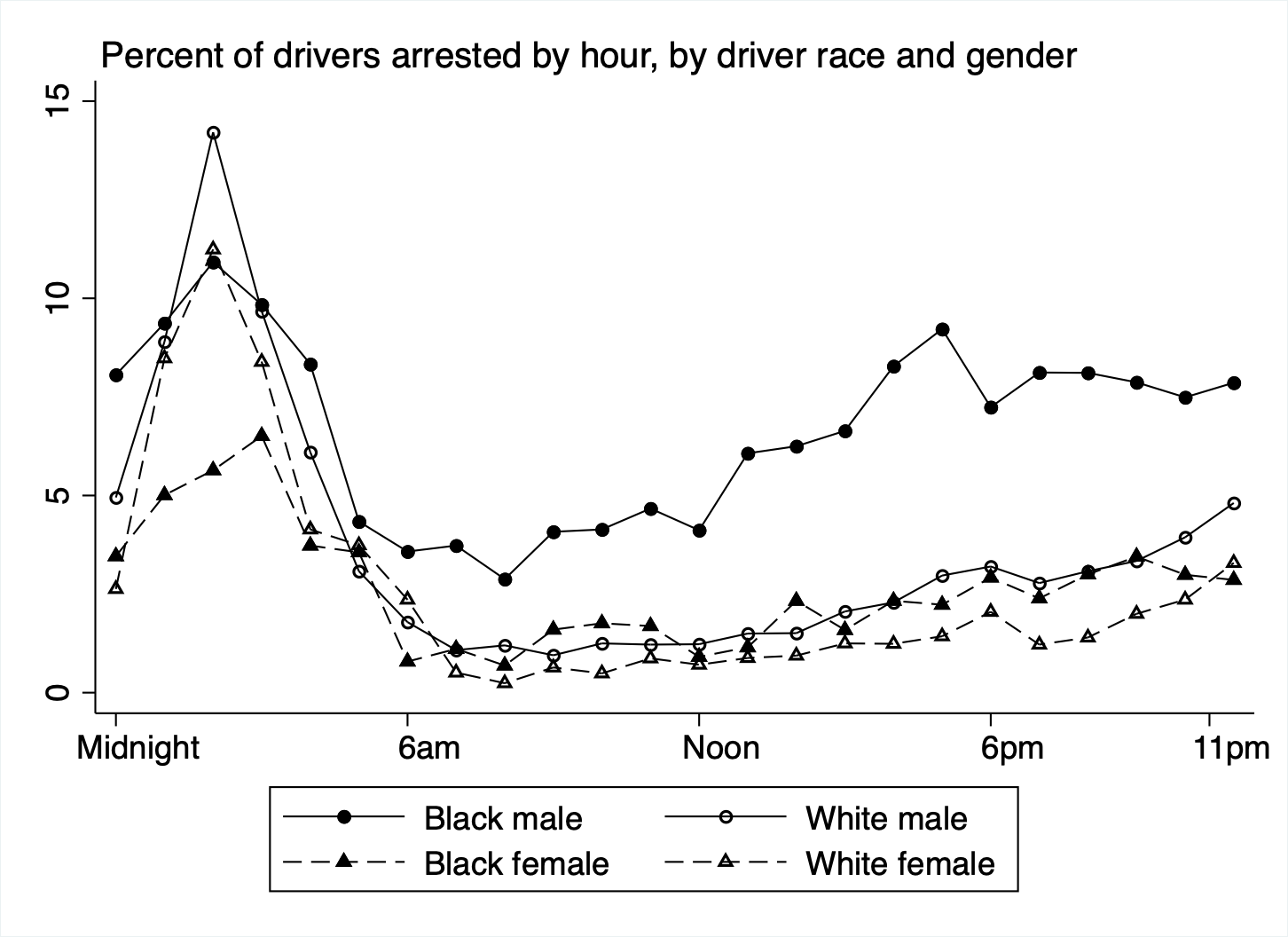
Figure 14 displays the percentage of traffic stops which result in an arrest for each race and gender category, by hour of the day. For all categories, drivers are more likely to be arrested during nighttime hours, specifically the hours directly after midnight. Black males are more likely to be arrested than all other drivers from 6 AM until midnight, which constitutes a large majority of the day. The other race and gender categories have similar rates of arrest during this period. The Figure also indicates that a large majority of stops do not result in an arrest regardless of race and gender category or time of day.
Figure 15. Number of stops by officer
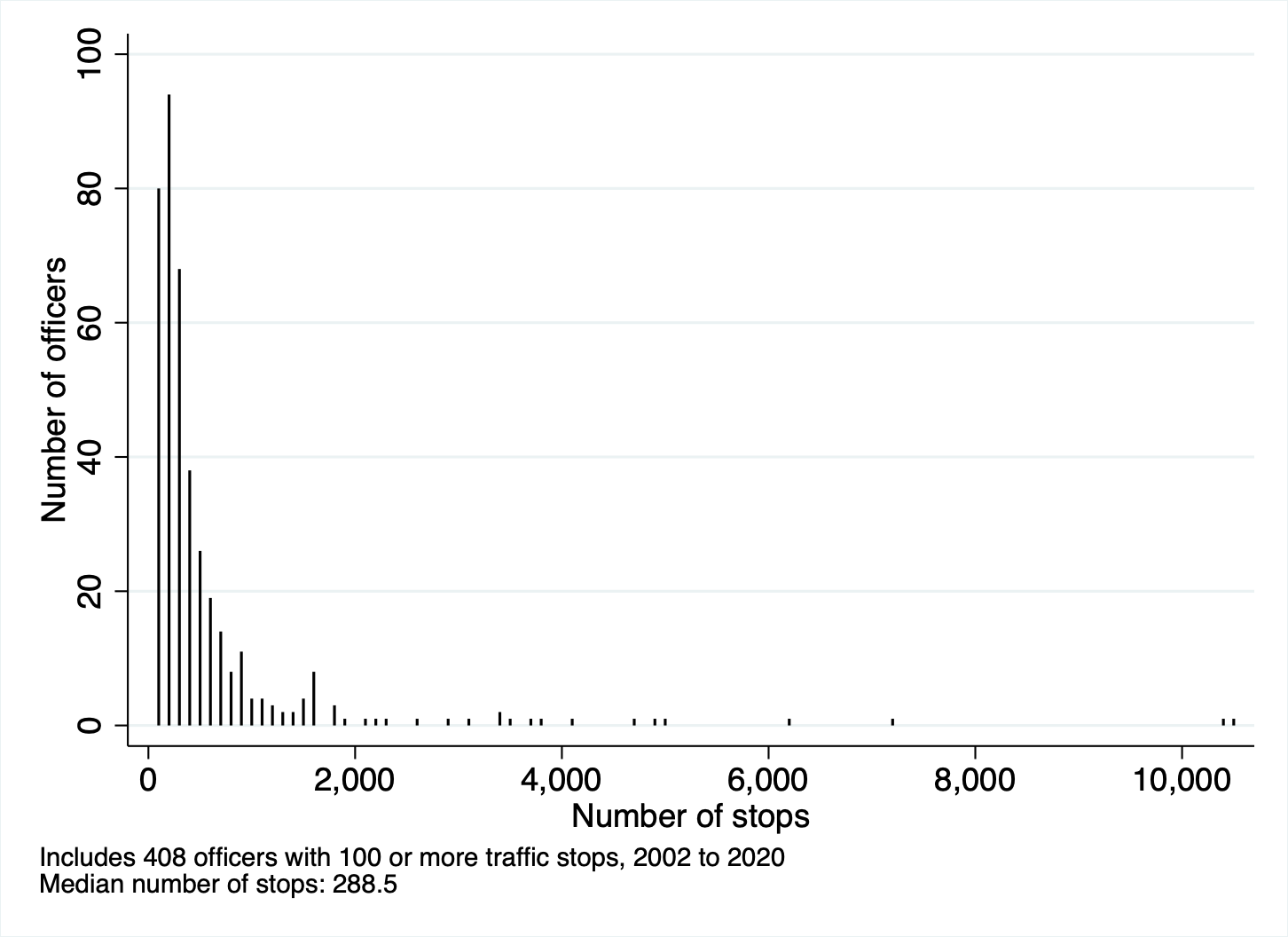
Figure 15 displays the distribution of number of stops by officer across the 2002-2020 time period. All officers displayed have over 100 traffic stops. 358 of the 408 officers included in the data have less than 1000 traffic stops.
Figure 16. Percent black of drivers pulled over by officer
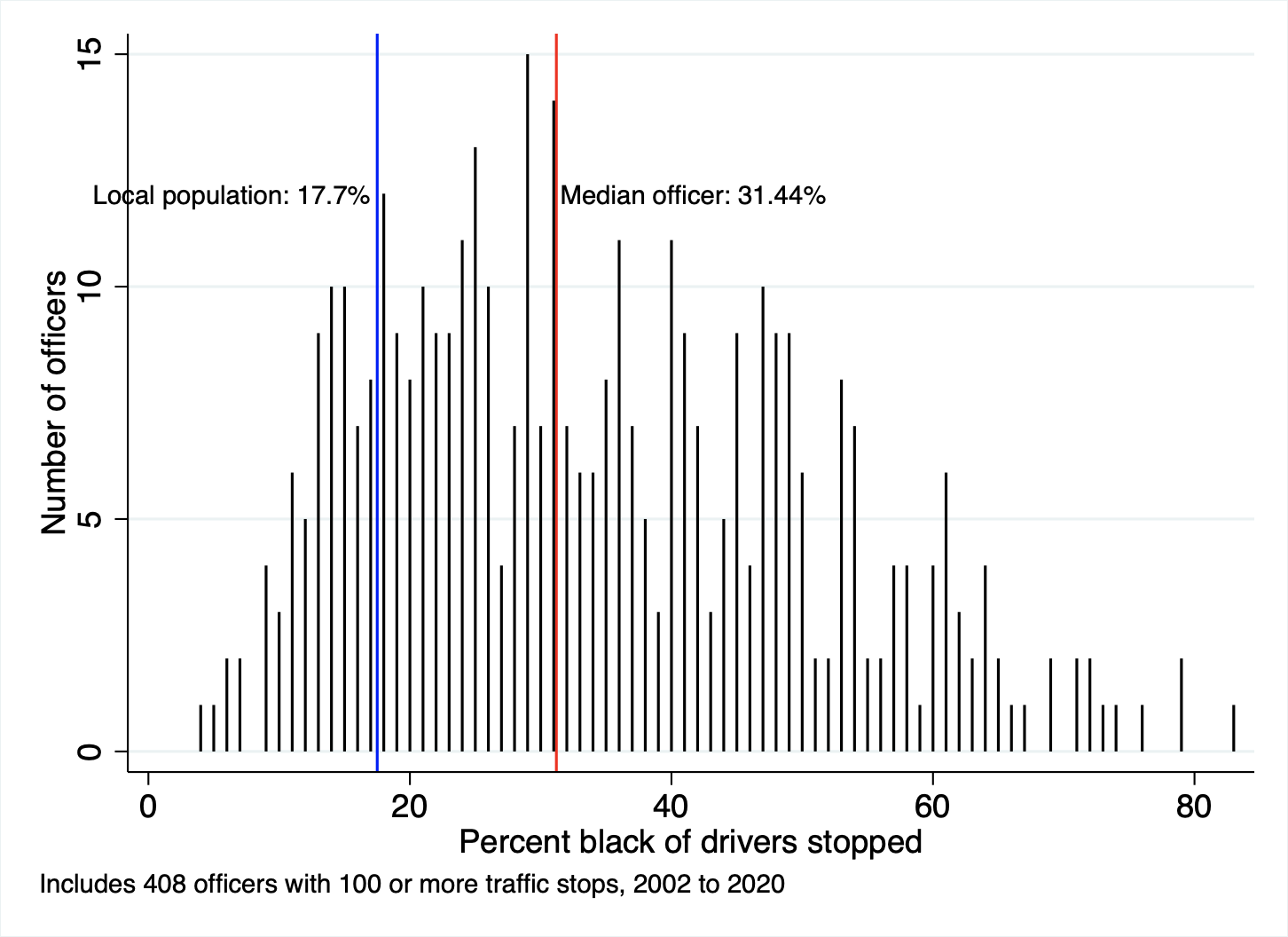
Figure 16 displays the percentage of stopped drivers that are black for individual officers, from 2002-2020. The distribution includes officers with greater than 100 traffic stops. For the median officer, 31.44% of stops are of black drivers, while black people only make up 17.7% of the population in the city. This means that a majority of officers are stopping black drivers at a rate disproportionate to their share of the population. This disparity between stop behavior and population data is often greater, with black drivers composing more than 60% of stops for a significant portion of officers. At the far right, the Figure shows that there are 32 officers whose mix of drivers stopped is more than 60% black.
Figure 17. Officer search rates by race
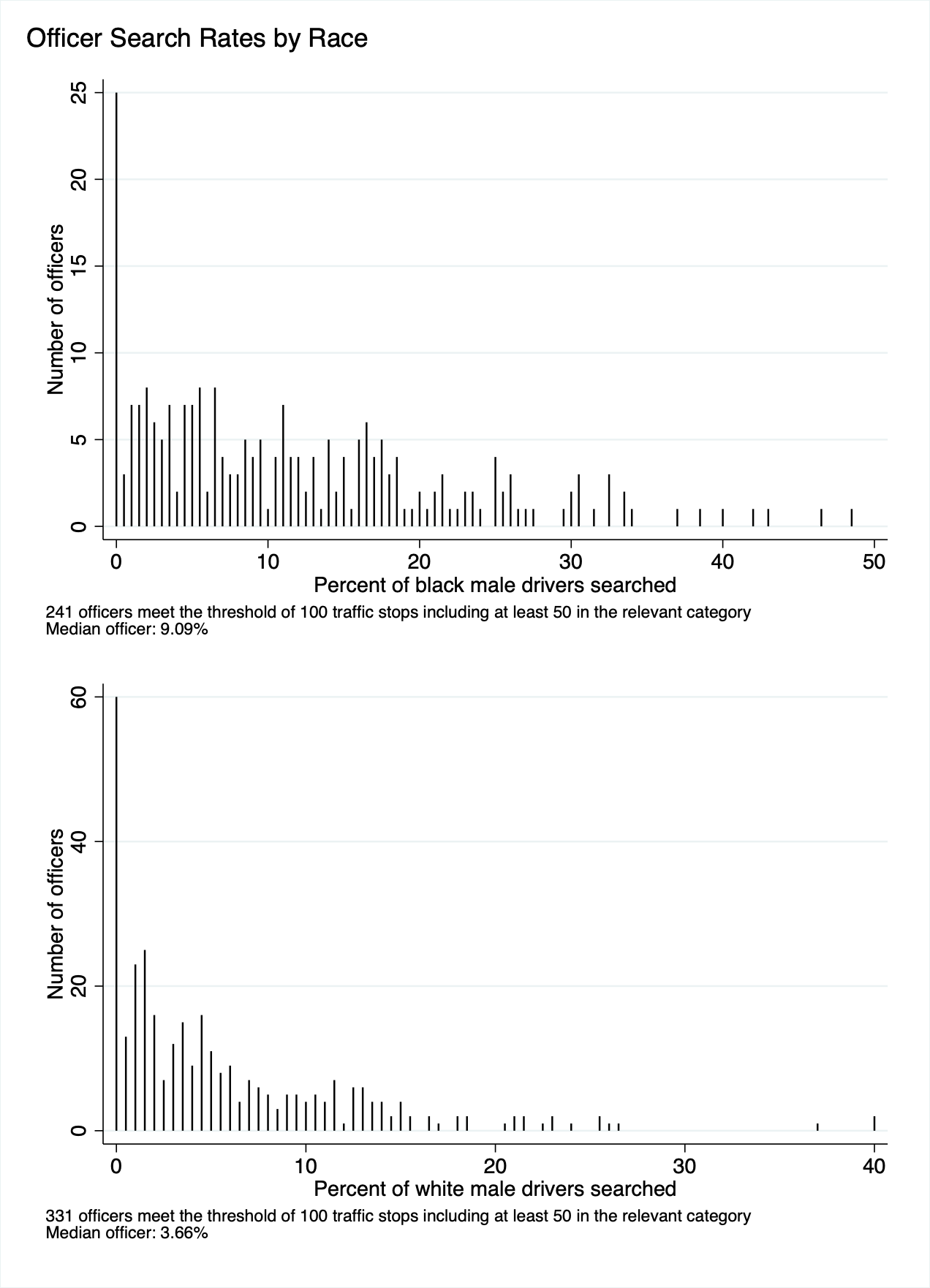
Figure 17 displays the search rates of individual officers for the given race and gender category. The criteria for an officer’s inclusion is 100 or more traffic stops, as well as at least 50 stops of the specified race and gender category, from 2002-2020. In the first graph, the median officer has a search rate of 9.09%, meaning that black male drivers are searched in 9.09% of traffic stops. Many officers have search rates that are higher than this median value, meaning that searches occur more often for certain officers in traffic stops involving black males. For white male drivers, the median officer has a search rate of 3.66%. This indicates that the median officer in Wilmington is searching black males at a higher rate than they are searching white males.
Figure 18. Black-White Ratio of search rates by officer, for males
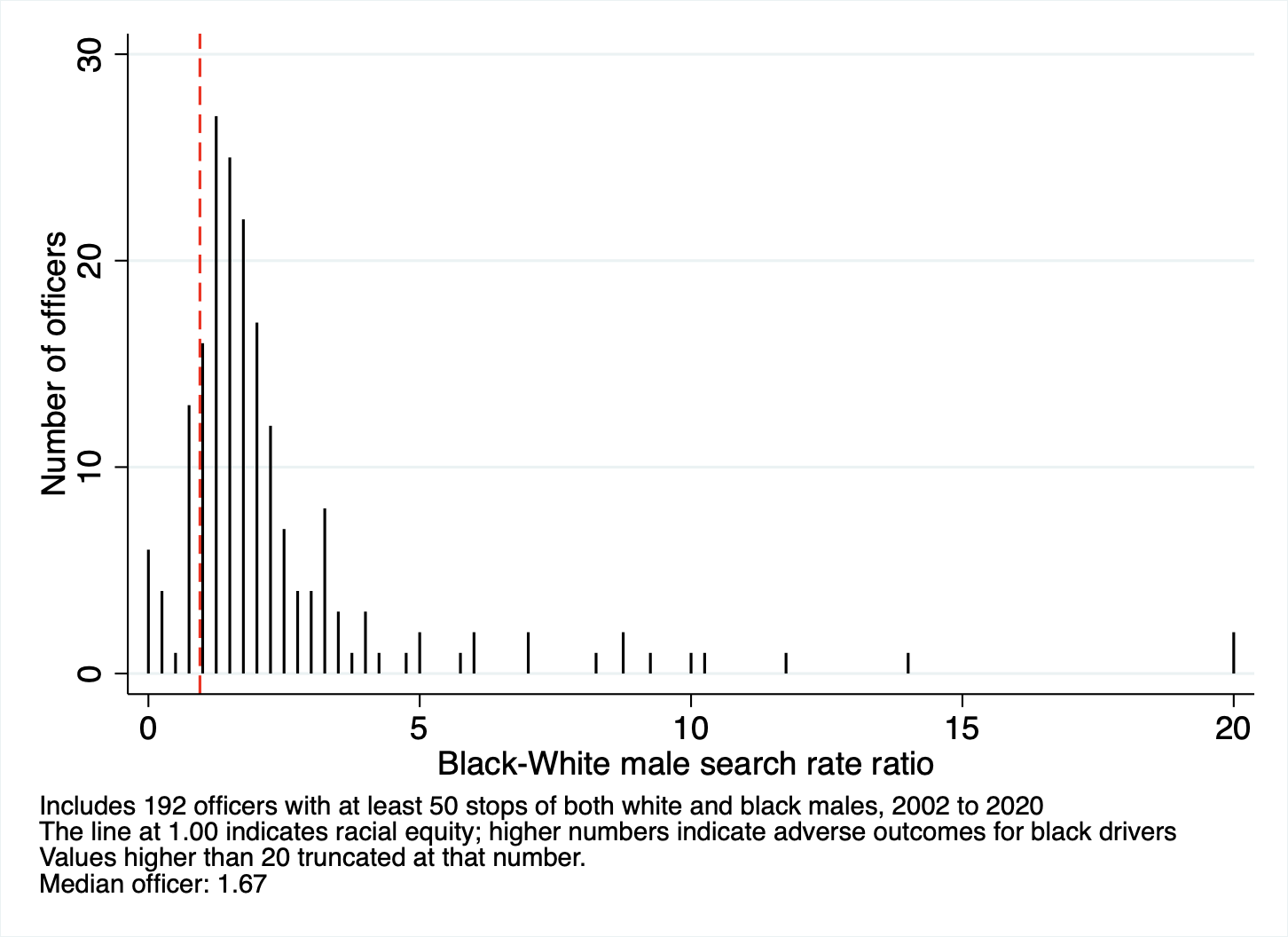
Figure 18 displays the distribution of black-white male search rate ratios across the officers which meet the criteria. The criteria for an officer’s inclusion is 50 traffic stops of both white males and black males, from 2002-2020. The “Black-white male search rate ratio” can be interpreted as an officer’s search rate of black male drivers divided by their search rate of white male drivers. An racially equitable outcome would therefore be 1, meaning that black and white male drivers are searched in an equal percentage of traffic stops. The median officer instead has a search rate ratio of 1.67, meaning that the median officer searches black male drivers at a higher rate than white male drivers. A significant number of officers have search-rate ratios that are much higher than the median, with some searching black male drivers at 3 or more times the rate of white male drivers.
Figure 19. Search rate versus hit rate by officer
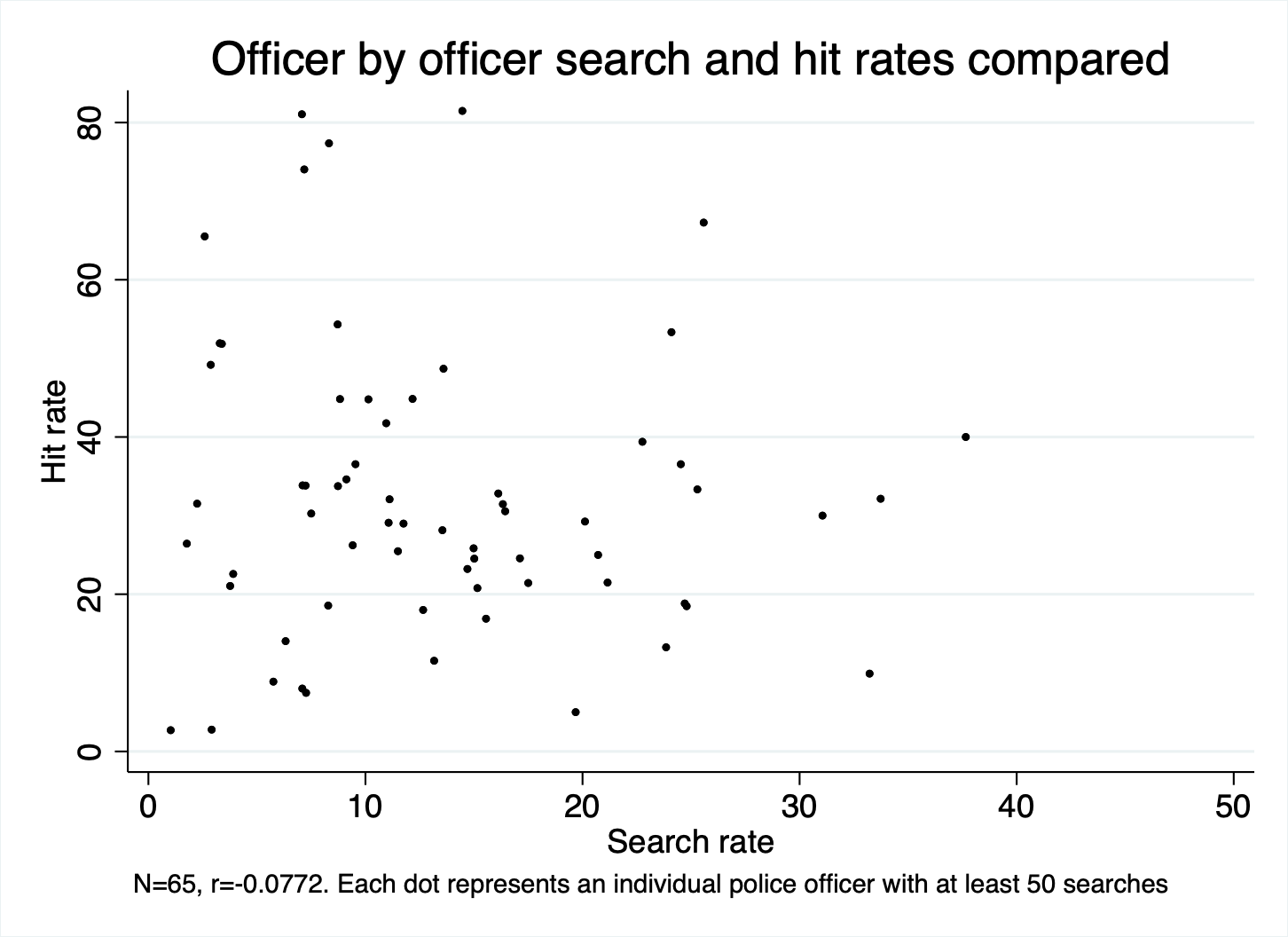
Figure 19 presents the hit rates and search rates of individual officers who meet the criteria. As evidenced by the low correlation, there is great variability in both the propensity of individual officers to search drivers and their success in finding contraband. One might expect that when officers have a high search rate but a low hit rate, that their supervisors would advise them to adjust their search rate in order to avoid so many fruitless searches. Similarly, for officers with low search rates but high hit rates, one might expect supervisors to instruct them to conduct more searches because they are being too cautious. Such a learning process would generate relative consistent hit rates; where officers are too high, they would be advised to do more searches, and where too low, to conduct fewer. The Figure shows clearly that this is not happening. Search and hit rates range from low to high, with a very low correlation between the two. Certain officers search drivers at extremely high rates but have very low hit rates, meaning that their threshold of suspicion is likely too low. Other officers search at a much lower rate and have very high hit rates, showing that their threshold of suspicion may be too high. Overall, the Figure shows that officers are not gravitating towards a single common range of hit rates. This suggests that the department does not seem to hold its officers to a common standard of search rate success. Rather, each officer decides for him or herself how aggressive to be in searching, with virtually no guarantee that more searches will lead to lower hit rates, or that fewer searches will be targeted on those most likely to have contraband.